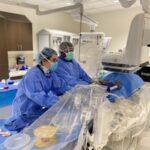.jpg) The celebration of the 92nd National Hospital week this May 6-12 provides an excellent opportunity to reassess that rapidly changing role of the hospital in an evolving health care system. American medicine of the previous century focused on the diagnosis and treatment of acute disease. Life expectancy in the year 1900 was 46.3 years for men and 48.3 years for women. There were no antibiotics, surgery was primitive by modern standards, and percutaneous interventional approaches were not even dreamed of. Tremendous strides were made – vaccines, antibiotics and other therapies, advances in surgery and critical care left the century with a life expectancy which had been prolonged to 73.9 for men and 79.4 for women. Heart disease, the leading killer of both men and women for the second half of the century has experienced a decline in mortality which has continued unabated for the past 25 years. In all of this progress, the hospital was the pinnacle of health care – the ultimate stage upon which the medical drama unfolded. Hospitals provided care for the sickest of patients, and served as the site where medical innovation was developed and medical education and research were culminated. In short, hospitals became the focus of medical care in America.
The celebration of the 92nd National Hospital week this May 6-12 provides an excellent opportunity to reassess that rapidly changing role of the hospital in an evolving health care system. American medicine of the previous century focused on the diagnosis and treatment of acute disease. Life expectancy in the year 1900 was 46.3 years for men and 48.3 years for women. There were no antibiotics, surgery was primitive by modern standards, and percutaneous interventional approaches were not even dreamed of. Tremendous strides were made – vaccines, antibiotics and other therapies, advances in surgery and critical care left the century with a life expectancy which had been prolonged to 73.9 for men and 79.4 for women. Heart disease, the leading killer of both men and women for the second half of the century has experienced a decline in mortality which has continued unabated for the past 25 years. In all of this progress, the hospital was the pinnacle of health care – the ultimate stage upon which the medical drama unfolded. Hospitals provided care for the sickest of patients, and served as the site where medical innovation was developed and medical education and research were culminated. In short, hospitals became the focus of medical care in America.Two converging trends appear to be changing that paradigm – one economic and one medical. In 1982, in an effort to control the costs of Medicare, Congress replaced cost-based reimbursement with a system of DRG’s, or diagnosis-related groups. Henceforth, hospitals were to be paid not based specifically on what they spent taking care of patients, but upon the diagnosis for which that care was being provided – to a certain extent, regardless of how much they spent in so doing. Given a more fixed reimbursement structure, hospitals developed quite successful strategies to reduce the very resource-intense in-house care – strategies to reduce the length of hospital stay were complemented by a growth in out-patient care, especially for minor procedures. The financial burden of hospital care remains a major focus of governmental policy and an active element in current debates on healthcare financing and fiscal policy. The persistently high cost of healthcare in America have refocused concern regarding hospital charges (see Steven Brill’s March 4, 2013 expose in Time magazine, “Bitter Pill: Why Medical Bills Are Killing Us”), and government policy is increasingly restrictive on hospital reimbursements. Reimbursements have already ceased for certain “never” diagnoses, such as return to the operating room for a retained foreign body, reimbursement has been reduced for hospitals demonstrating greater than average rates of readmission for certain diagnoses, and there are planned scale-backs in the additional reimbursement for medical education in teaching hospitals. The unfortunate reality of these policy directives is that, although financially meaningful, they are frequently medically inappropriate. For example, much of the data on readmission indicates that it is social and economic more than medical factors that tend to drive hospital readmissions. Therefore, those hospitals serving the underpriviledged, which are most in need of resources, are actually the ones which are being disproportionately penalized by current policy.
This leads us to second major trend in impacting the role of the hospital. Whereas the healthcare system we have developed is well-suited to the treatment of acute disease, our successes in this arena have shifted the burden of disease into the more chronic realm. Congestive heart failure, medically and interventionally managed coronary artery disease, cancer, diabetes (in large part driven by an epidemic of obesity), auto-immune/inflammatory disease are the major challenges facing the medical profession. Although hospital care is not infrequently appropriate in the course of management of these conditions, the focus is no longer the hospital, but rather the patient. There is a need for a system of interactive and coordinated care which ultimately and ideally will engage not only the physicians and their extenders, but the patient as well.
How the hospitals negotiate this new terrain of coordinated patient-centered care will largely determine their viability and purpose in the coming years. In this milieu, the Florida Heart Research Institute as a fully independent non-profit organization provides a vital resource to help local institutions better integrate with the community in the areas of prevention, worksite wellness, and scientific research.

























